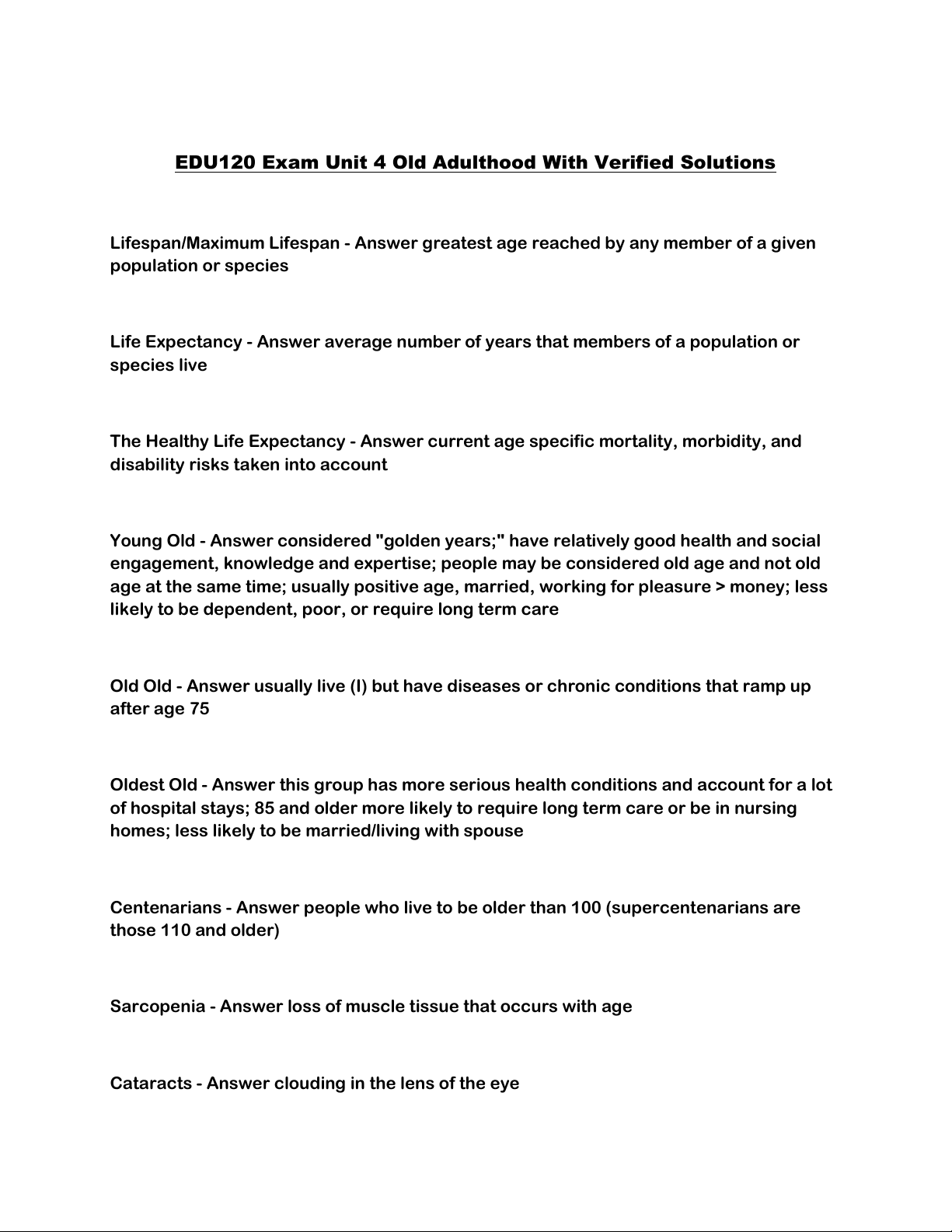
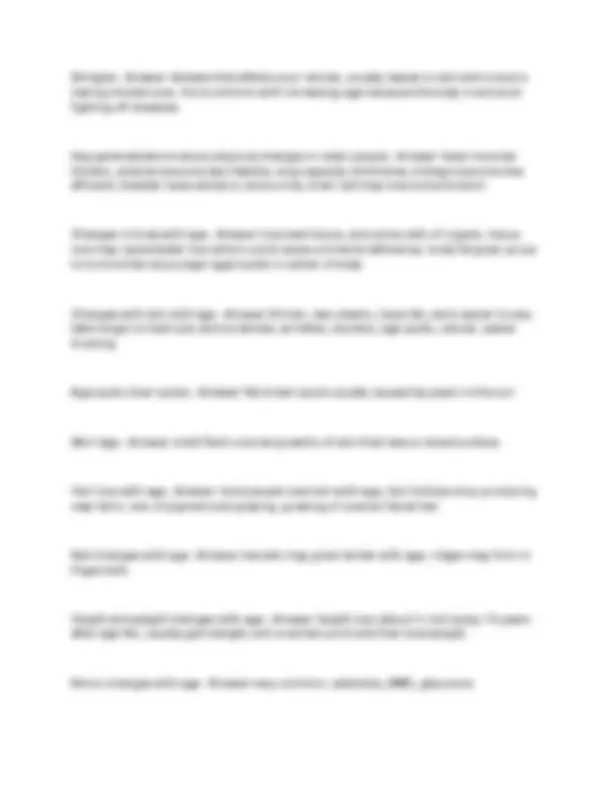
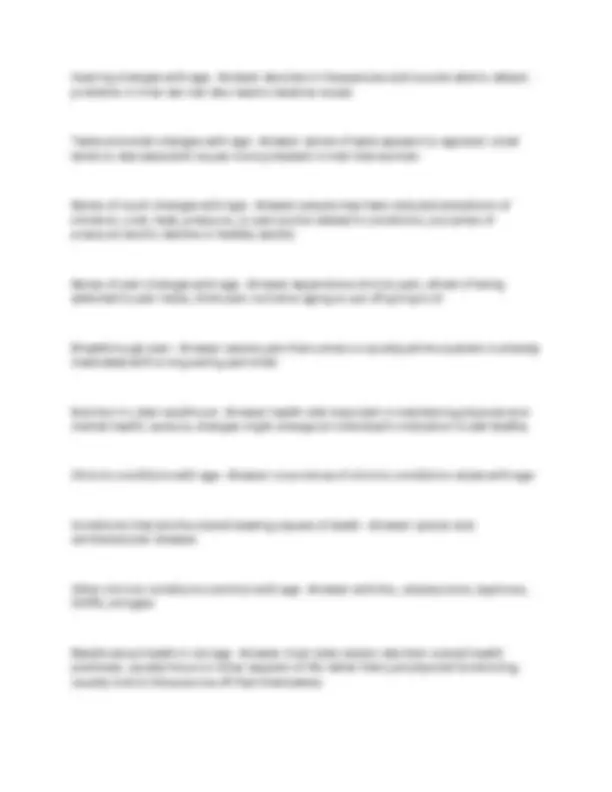
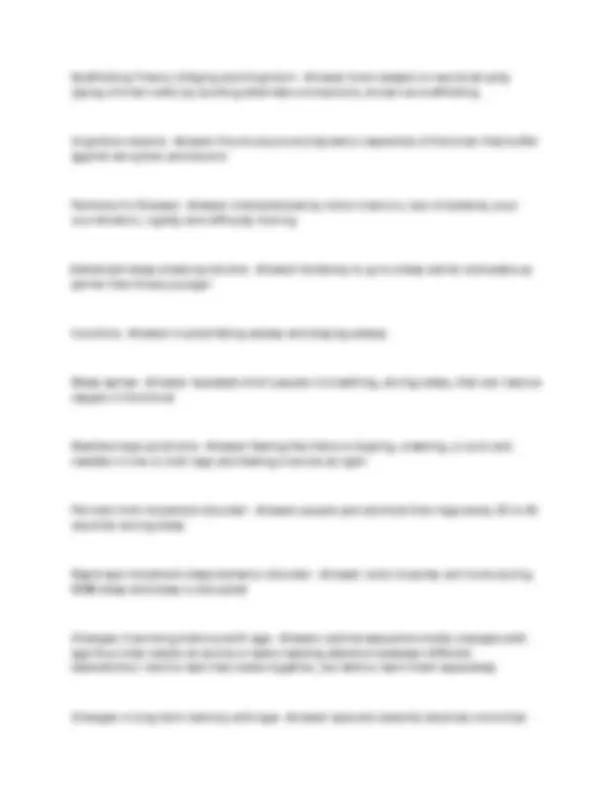
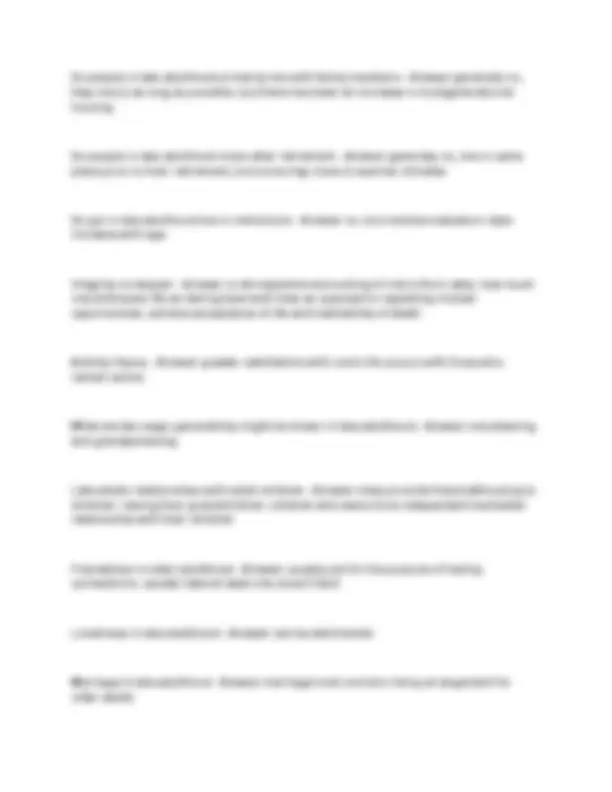
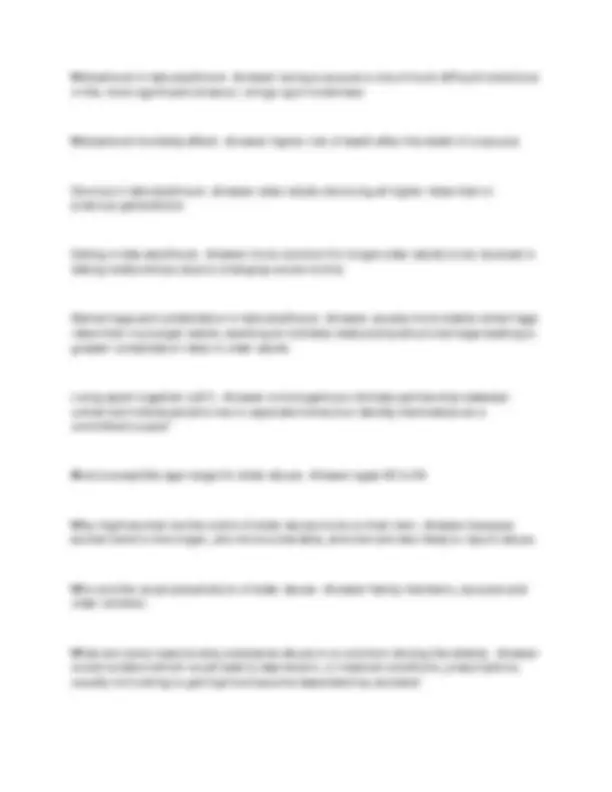
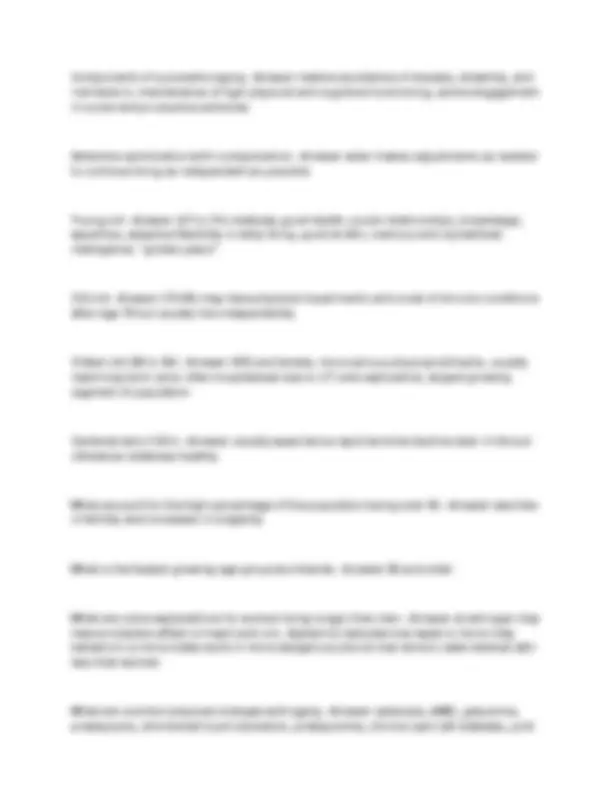
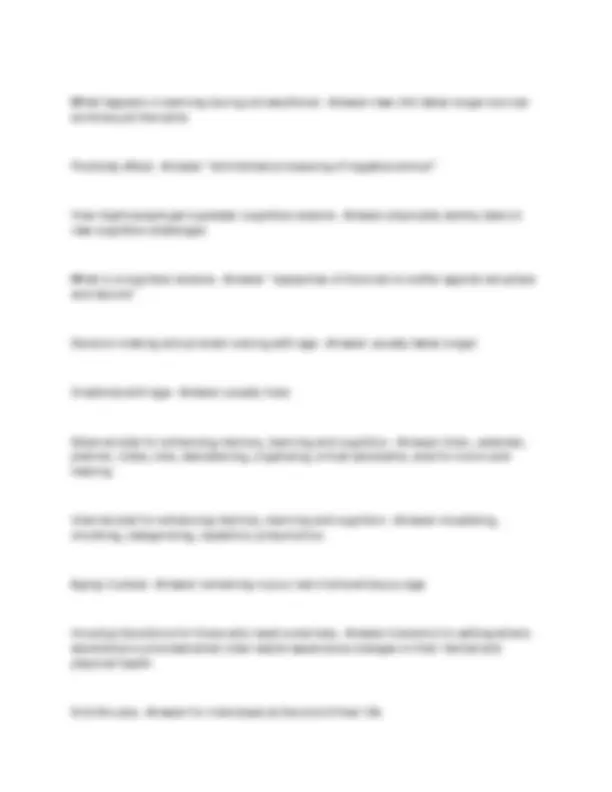
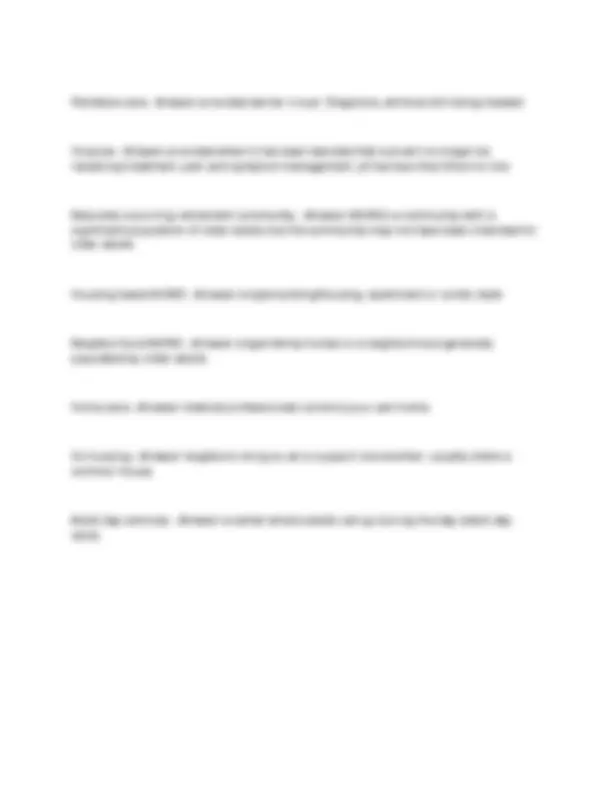


Study with the several resources on Docsity

Earn points by helping other students or get them with a premium plan


Prepare for your exams
Study with the several resources on Docsity

Earn points to download
Earn points by helping other students or get them with a premium plan
Community
Ask the community for help and clear up your study doubts
Discover the best universities in your country according to Docsity users
Free resources
Download our free guides on studying techniques, anxiety management strategies, and thesis advice from Docsity tutors
A comprehensive overview of key concepts and changes associated with old adulthood. It covers physical, cognitive, and social aspects of aging, including common health conditions, cognitive decline, and social adjustments. The document also explores ageism and its impact on older adults. While it offers a good starting point for understanding aging, it lacks in-depth analysis and critical evaluation.
Typology: Exams
1 / 14

This page cannot be seen from the preview
Don't miss anything!









Lifespan/Maximum Lifespan - Answer greatest age reached by any member of a given population or species
Life Expectancy - Answer average number of years that members of a population or species live
The Healthy Life Expectancy - Answer current age specific mortality, morbidity, and disability risks taken into account
Young Old - Answer considered "golden years;" have relatively good health and social engagement, knowledge and expertise; people may be considered old age and not old age at the same time; usually positive age, married, working for pleasure > money; less likely to be dependent, poor, or require long term care
Old Old - Answer usually live (I) but have diseases or chronic conditions that ramp up after age 75
Oldest Old - Answer this group has more serious health conditions and account for a lot of hospital stays; 85 and older more likely to require long term care or be in nursing homes; less likely to be married/living with spouse
Centenarians - Answer people who live to be older than 100 (supercentenarians are those 110 and older)
Sarcopenia - Answer loss of muscle tissue that occurs with age
Cataracts - Answer clouding in the lens of the eye
Age related macular degeneration - Answer loss of clarity in the center field of vision due to deterioration of the macula (the center of the retina)
Glaucoma - Answer loss of peripheral vision, usually due to buildup of fluid in the eye that damages the optic nerve
Presbycusis - Answer common form of hearing loss in late adulthood that results in a gradual loss of hearing
Tinnitus - Answer a ringing, hissing or roaring sound in the ears
Presbyosmia - Answer loss of smell due to aging
Anosmia - Answer total loss of smell
Chronic illnesses - Answer illnesses that are ongoing, generally incurable conditions that require continuing medical intervention and effect daily life
Osteoporosis - Answer disease that weakens and thins bones to the point that they become fragile and break easily
Kyphosis - Answer adults gradually lose height and become hunched over due to bones weakening in the spine
Chronic obstructive pulmonary disease (COPD) - Answer progressive lung disease where the airways become damaged making it harder to breathe
Cirrhosis - Answer disease where the liver becomes scarred and does not function properly
Hearing changes with age - Answer declines in frequencies and sounds able to detect; problems in inner ear can also lead to balance issues
Taste and smell changes with age - Answer sense of taste appears to age well; smell tends to decrease with issues more prevalent in men than women
Sense of touch changes with age - Answer people may have reduced sensations of vibration, cold, heat, pressure, or pain (some related to conditions, but sense of pressure tend to decline in healthy adults)
Sense of pain changes with age - Answer experience chronic pain; afraid of being addicted to pain meds; think pain normal w aging so put off going to dr
Breakthrough pain - Answer severe pain that comes on quickly while a patient is already medicated with a long acting pain killer
Nutrition in older adulthood - Answer health diet important in maintaining physical and mental health; sensory changes might change an individual's motivation to eat healthy
Chronic conditions with age - Answer occurrence of chronic conditions raises with age
Conditions that are the overall leading causes of death - Answer cancer and cardiovascular disease
Other chronic conditions common with age - Answer arthritis, osteoporosis, kyphosis, COPD, shingles
Beliefs about health in old age - Answer most older adults rate their overall health positively; usually focus on other aspects of life rather than just physical functioning; usually look to those worse off than themselves
Scaffolding Theory of Aging and Cognition - Answer brain adapts to neural atrophy (dying of brain cells) by building alternate connections, known as scaffolding
Cognitive reserve - Answer the structure and dynamic capacities of the brain that buffer against atrophies and lesions
Parkinson's Disease - Answer characterized by motor tremors, loss of balance, poor coordination, rigidity and difficulty moving
Advanced sleep phase syndrome - Answer tendency to go to sleep earlier and wake up earlier than those younger
Insomnia - Answer trouble falling asleep and staying asleep
Sleep apnea - Answer repeated short pauses in breathing, during sleep, that can reduce oxygen in the blood
Restless legs syndrome - Answer feeling like there is tingling, crawling, or pins and needles in one or both legs and feeling is worse at night
Periodic limb movement disorder - Answer people jerk and kick their legs every 20 to 40 seconds during sleep
Rapid eye movement sleep behavior disorder - Answer one's muscles can move during REM sleep and sleep is disrupted
Changes in working memory with age - Answer central executive mostly changes with age thus older adults do worse in tasks needing attention between different tasks/stimuli; hard to learn two tasks together, but able to learn them separately
Changes in long term memory with age - Answer episodic (events) declines more than
Vascular neurocognitive disorder - Answer blockage in cerebral blood vessels that affects one part of brain (as opposed to a general loss); comes on more quickly than DAT and lasts shorter before death
Neurocognitive disorder with lewy bodies - Answer lewy bodies are micro protein deposits that are in neurons; affects chemicals in brain that affects thinking, movement, behavior and mood
Bridge Jobs - Answer part time jobs that occur between career and retirement
Encore Careers - Answer work in a different field from where the individual retired
Age discrimination in employment act - Answer mandatory retirement eliminated for most employers; most ppl can continue to work if they are able and want to; rules for social security benefits
Ageism - Answer prejudice based on age (believe that aging brings poor health and mental decline)
Self fulfilling prophecy - Answer the belief that one's ability results in actions that make it come true
Stereotype threat - Answer being the target of stereotyping can negatively affect an individual's performance on tasks because they worry they will conform to the cultural stereotype
Triple jeopardy - Answer people who face ageism, racism, and sexism
Living arrangements for older adults - Answer most don't live alone; live with spouse or partner or children; majority of older adults living alone are women
Do people in late adulthood primarily live with family members - Answer generally no, they live (I) as long as possible; but there has been an increase in multigenerational housing
Do people in late adulthood move after retirement - Answer generally no, live in same place prior to their retirement, but some may move to warmer climates
Do ppl in late adulthood live in institutions - Answer no; but institutionalization rates increase with age
Integrity vs despair - Answer a retrospective accounting of one's life to date; how much one embraces life as having been well lives as opposed to regretting missed opportunities; achieve acceptance of life and inevitability of death
Activity theory - Answer greater satisfaction with one's life occurs with those who remain active
What are two ways generativity might be shown in late adulthood - Answer volunteering and grandparenting
Late adults relationships with adult children - Answer many provide financial/housing to children; raising their grandchildren; children who were more independent had better relationship with their children
Friendships in older adulthood - Answer usually just for the purpose of having connections; usually have at least one close friend
Loneliness in late adulthood - Answer can be detrimental
Marriage in late adulthood - Answer marriage most common living arrangement for older adults
Components of successful aging - Answer relative avoidance of disease, disability, and risk factors; maintenance of high physical and cognitive functioning; active engagement in social and productive activities
Selective optimization with compensation - Answer elder makes adjustments as needed to continue living as independent as possible
Young old - Answer (67 to 74) relatively good health, social relationships, knowledge, expertise, adaptive flexibility in daily living; good at attn, memory and crystallized intelligence; "golden years"
Old old - Answer (75-84) may have physical impairments and onset of chronic conditions after age 75 but usually live independently
Oldest old (85 to 99) - Answer 60% are female; more serious physical ailments; usually need long term care; often hospitalized due to UTI and septicemia; largest growing segment of population
Centenarians (100+) - Answer usually experience rapid terminal decline later in life but otherwise relatively healthy
What account for the high percentage of the population being over 65 - Answer declines in fertility and increases in longevity
What is the fastest growing age group world wide - Answer 85 and older
What are some explanations for women living longer than men - Answer a) estrogen may have protective effect on heart and circ. System b) testosterone leads to more risky behaviors c) more males work in more dangerous jobs d) men tend to seek medical attn less than women
What are common physical changes with aging - Answer cataracts, AMD, glaucoma, presbycusis, diminished touch sensation, presbyosmia, chronic pain (d/t diabetes, joint
pain, sciatica, shingles)
lifespan/maximum lifespan - Answer greatest age reached by any member of a given population (or species); for humans this is around 120 to 125
Life expectancy - Answer the average number of years that members of a population (or species) live
Elder abuse - Answer "intentional act or failure to act, by a caregiver or another person in a relationship involving an expectation of trust that causes or creates a risk of harm to an older adult"
5 kinds of elder abuse - Answer physical, sexual, psychological/emotional, financial/exploitation, neglect & abandonment
Whats your responsibility in elder abuse situations - Answer any person in a position with an older adult must report suspicions of elder abuse then adult protective services will take over
3 commonly recognized components of aging well - Answer 1) avoid diseases and their risk factors (high bp, smoking, obesity) 2) maintain high physical and cognitive functioning 3) actively engage in social and productive activities
What percentage of aging is genetically determined - Answer 30%
Blue zone areas - Answer areas in the globe that have the longest lived cultures
The power 9 - Answer 1) find stress relief strategy 2) wake up w purpose ea day 3) less meat and more veggie 4) enjoy wine w friends ea day 5) eat mindfully and stop when 80% full 6) find ways to move 7) surround w people who support your beliefs 8) invest time w family 9) belong to faith based community and attend 4x/mon
What happens in learning during old adulthood - Answer new info takes longer but can be done just the same
Positivity effect - Answer "diminished processing of negative stimuli"
How might people get a greater cognitive reserve - Answer physically active, take on new cognitive challenges
What is a cognitive reserve - Answer "capacities of the brain to buffer against atrophies and lesions"
Decision making and problem solving with age - Answer usually takes longer
Creativity with age - Answer usually rises
External aids for enhancing memory, learning and cognition - Answer timer, calendar, planner, notes, lists, decluttering, organizing, virtual assistants, aids for vision and hearing
Internal aids for enhancing memory, learning and cognition - Answer visualizing, chunking, categorizing, repetition, pneumonics
Aging in place - Answer remaining in your own home while you age
Housing transitions for those who need some help - Answer transition to setting where assistance is provided when older adults experience changes in their mental and physical health
End life care - Answer for individuals at the end of their life
Palliative care - Answer provided earlier in a pt. Diagnosis, while pt still being treated
Hospice - Answer provided when it has been decided that a pt will no longer be receiving treatment; pain and symptom management; pt has less than 6mon to live
Naturally occurring retirement community - Answer (NORC) a community with a significant population of older adults but the community may not have been intended for older adults
Housing based NORC - Answer single building/housing; apartment or condo style
Neighborhood NORC - Answer single family homes in a neighborhood generally populated by older adults
Home care - Answer medical professionals come to your own home
Co housing - Answer neighbors living so as to support one another; usually share a common house
Adult day services - Answer a center where adults can go during the day (adult day care)